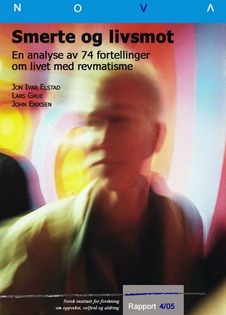| dc.description.abstract | The aim of the project was to study consequences of having a rheumatic disease within a biographical framework. Important research issues were how rheumatism affects daily life, what kind of treatments the informants underwent, and the influence of the disease on social life, working life and the life course. A total of 125 members of Norsk Revmatikerforbund (Norwegian Rheumatism Association) were randomly selected. Among them, 23 did not have an active rheumatic disease. Among the rest, 74 persons agreed to participate. The sample consisted of 53 women and 21 men; 39 of them were in their thirties, 35 in their fifties. Data were collected by telephone interviews during autumn 2003 and winter/spring 2004. The interviews lasted usually about 50-60 minutes. The structured questionnaire had both fixed and open ended questions.A considerable period of time had often passed from the manifestation of the disease until the condition was properly diagnosed. Three out of ten had to wait more than five years before a diagnosis was definitely made. Half of the 74 informants had rheumatoid arthritis or «Bechterew's disease» (ankylosing spondylitis). Because of the disease many experienced a biographical disruption that changed their life course. One third of the informants reported that getting a rheumatic disease was the most traumatic event in their life and three out of four meant that life would have been substantially better without the disease. Many reported stiffness, inflammations, daily pain and various forms of activity limitations. However, the impact of the disease varied a lot between different informants. Also, many experienced that their disease had fluctuating courses, varying between relatively bad and relatively good periods.The majority felt that they had an identity as a person with rheumatism; however, only a few would call themselves disabled. Most of the informants held the opinion that a hereditary disposition was the cause for the disease. Nearly no one meant that they themselves could have done anything to avoid getting the disease.The majority used painkillers and other drugs on a daily basis and many had frequent contacts with a physician, both in order to receive treatments and in order to undergo examinations.Some consulted usually a general practitioner for their rheumatism while others had their regular physician contact with a rheumatologist. A third group combined the two types of doctors. Patients consulting a rheumatologist were often more satisfied, both with the information they received and generally with their contacts with doctors, than patients usually consulting a general practitioner. On the whole, less than half reported a high level of satisfaction with the information they received from their doctors. Three out of ten had undergone surgery because of their rheumatism, resulting in long-lasting improvements for only about half of them, however. Those who had been to rehabilitation or health centers in places with warm and sunny climate (usially Sothern Europe) all claimed that they had benefited much, although temporary. The social security system reimburses costs for treatment and medicines when these exceed a certain, not very high, threshold (about 1400 Norwegian Kroner in 2003, i.e., about 160 Euros). Nevertheless, as many as one third of the informants reported that the financial costs related to having a rheumatic disease were an economic burden. Many informants reported specific expenses related for instance to clothing, special car equipment, warm baths, or indoor heating - expenses which were only partly reimbursed and which therefore partly had to be covered by the sick person herself. The experience of economic difficulties was in particular the case among patients who seemed to have modest incomes, for instance because of unemployment or because they were disability pension recipients. It seemed that those who suffered most from the disease and therefore had the highest costs, also often had the lowest incomes available for covering the costs.A clear majority had had to adjust their working life to their rheumatic disease. Among those in their fifties two out of three were disability pension recipients. Many retired informants had wished to continue in employment. In hindsight, most were nevertheless happy for being relieved from their burdensome working life, giving them opportunities for spending more time on other, often social, commitments.One out of three reported that they had experienced employers who clearly wanted them to resign because of the disease. Others had however experienced understanding and sympathetic employers who had offered to make various accommodations so that the informant could stay longer in the workforce.Two out of three had a partner and many lived an active social life. Physical exercise, having «positive attitudes» and participating in social life were generally considered to be the best coping strategies by the informants. However, some reported that troubles and pains connected with the disease restricted their social life and some said that the disease was the reason they had got divorced.Several women reported that doctors had advised them not to have children because of the disease. Practically everyone said they «understated» their troubles and pains, because they did not want to be looked upon as a person always «complaining and whimpering».Even if the majority felt they were in control of the disease, one out of four experienced to be controlled by the disease. Nevertheless, overall the informants reported fairly good quality of life and they generally seemed to have fairly optimistic views on their existence and on their future. | en |
